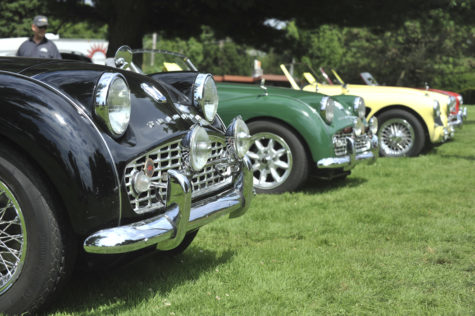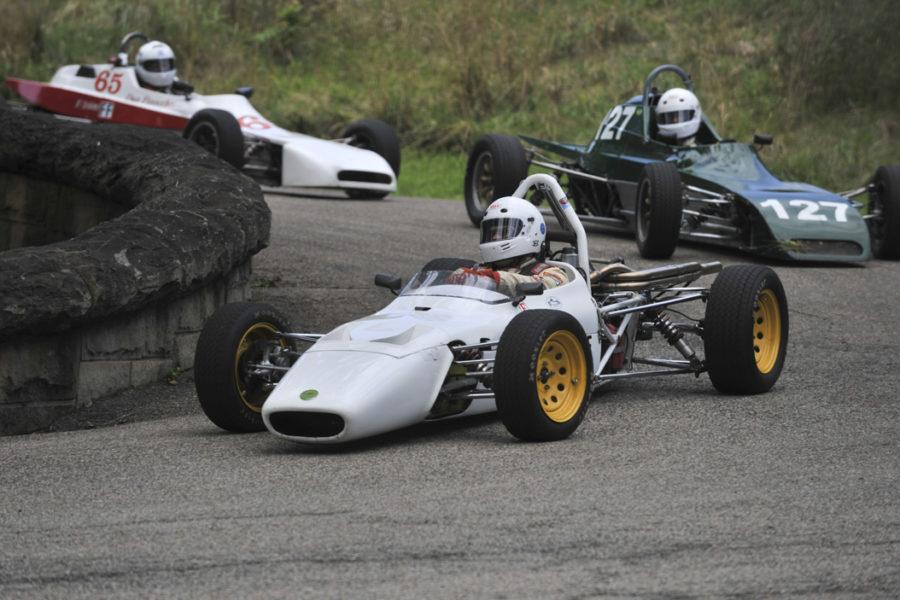Speeding around the 90-degree turn at 60 mph, the bustling race track swarmed with bright-colored vintage sports cars rushing to the finish line.
Sitting on the edge of Flagstaff Hill, crowds cheered on their favorite vintage car racers for the 35th annual Pittsburgh Vintage Grand Prix as the cars cut around the winding streets of Schenley Park.
Over 200,000 vintage car fans gathered in the park during the past weekend for the nation’s largest vintage sports car racing event. The course is the only race in the country that still runs on public streets and attracts about 150 vintage racers each year.
For Kevin and Nancy Sweeney, Pitt alumni who graduated in 1976, it’s a tradition to come back every year to spectate. They’ve attended the event more than 12 times.
“I love hearing the engines, seeing if anything happens in the race, watching racers lapping each other,” Kevin said.
The PVGP involves 10 days of motorsport events with a Kick-Off Rally on July 2, ending with the Vintage Races Sunday. Throughout the week, the events include a Downtown parade, a gala, car shows and tune-ups.
The 2.33 mile circuit is considered to be one of the most challenging courses nationwide, containing 23 turns, hay bales, manhole covers, phone poles and stone walls. Racing groups are categorized by engine size and year of manufacture.
While modern tracks are often built with large complexes and cost millions of dollars to build, the Schenley track is lined with features matching the spirit of the original sports car racing days. The start and finish line is located near Bartlett and Beacon Streets with several hard turns and and curbs throughout.

On Saturday and Sunday, there were 14 to 15 races per day that lasted about 30 minutes each. Each driver had to complete 10 laps that looped around the Panther Hollow Bridge to German Hill. With several areas open to spectate, crowds formed at every turn to watch the racers bank through and accelerate out of the turns.
During PVGP Race Weekend, the International Car Show stood alongside the races, displaying more than 2,500 vehicles, including Lamborghinis, Corvettes and vintage cars from different countries. Attendees could pose inside sports cars with music, food trucks and vendors right across the Bob O’Connor Golf Course.
The events bring in people of all likes from around the country, such as former racers and vintage racing enthusiasts.
Russ Kyler, a Pitt alum from Spring Church, Pennsylvania, used to race sprint cars and go-karts back in the 1980s. He also worked on building road race cars for the professional series.
“I didn’t grow up in a racing family but one of my neighbors raced and I used to go over and hang out when I was little,” he said. “Then when I was at Pitt, I got involved with other students who taught me how to put the cars together. We’ll go to the races and if anyone needs help with their cars we’ll help. If not, then we’ll watch.”
Kyler also travels around the state to Harrisburg, Lincoln and Port Royal to watch sprint car races.
All of the proceeds from the event go to charity — for the Autism Society of Pittsburgh and Allegheny Valley School — and about 1,000 volunteers run the events.
Steve Knapp, of Uniontown, Pennsylvania, is a spectator who likes to combine his love for art and vintage cars when attending races.
“I live for this. I like that any money you spend here goes to a good cause and everything’s volunteer. This is one of the best deals in the country.”
As a former graphic artist, he enjoys attending vintage races and then draws the cars afterward.
“I do a lot of racing art. All I want to do is draw cars. I’m starting to do that again. I joined a local art club and display in a few art galleries. I would love to retire and come here someday,“ he said.
Despite going to several races each year, Pittsburgh is his favorite.
Kyler remembers his first time coming to the race after a late night of tinkering with his own sprint car.
“The first time I came here I worked on a sprint car on Saturday night and got home at three in the morning and I said ‘I’m getting up at one’ and then I woke up at like seven or eight the next morning and came here. I’ve been coming ever since,” he said.
Although he no longer races anymore, he goes to as many races as he can to watch and occasionally works on vintage car projects of his own.
“You come here once, you’re coming back,” Knapp said.



